What causes Tire Feathering: Unraveling the Mystery
Introduction-
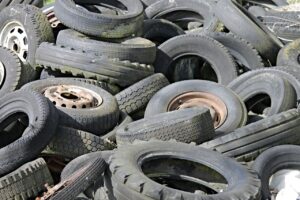
As we embark on journeys, our vehicles bear the weight of our adventures. Amidst the mechanical marvels, a tire’s role often goes unnoticed until something goes awry. One such enigma in the realm of tire woes is “tire feathering.” This article delves deep into the intricacies of this phenomenon. What causes tire feathering? What are its effects? How can we thwart its unwelcome presence?
What is Tire Feathering?
Picture this: You’re running your hand over your tire’s tread, and you notice an uneven texture – almost like a bird’s feather. That is tire feathering. Irregular wear pattern occurs when the tread blocks on your tire exhibit rounded edges on one side and sharper edges on the other. It is like a silent cry for attention from your tires.

The Science Behind Tire Feathering
Before we delve into the why, let’s understand the how. Tire wear occurs due to the friction between the tires and the road. As you drive, the tire’s rubber meets the pavement, generating heat and wear. However, the evenness of this wear can be disrupted by various factors, leading to tire feathering.
What causes Tire Feathering?
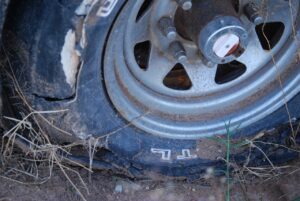
Misaligned Wheels: A Common Culprit that causes tire feathering
**Wheels out of Sync**
Wheel alignment is akin to harmony in the tire universe. When your wheels aren’t properly aligned, the tires meet the road at awkward angles. This creates uneven wear that eventually causes tire feathering.
Improper Tire Rotation: Neglecting Even Distribution
**Unequal Treat**
Tire rotation is a chore often dismissed. However, it plays a pivotal role in maintaining even wear. Neglecting rotation can result in certain tires bearing more load, causing tire feathering in select spots.
Incorrect Tire Inflation: Pressure Matters
**Under the Pump**
Tires, like Goldilocks’ porridge, need the right pressure – not too high, not too low. Overinflation or underinflation disrupts the uniform contact between the tread and the road. This causes tire feathering at the edges.
Suspension Woes: Impact on Alignment
**Bumpy Roads, Bumpier Treads**
Your vehicle’s suspension system isn’t just about a smooth ride; it affects tire wear too. Damaged or worn-out suspension components can knock wheels out of alignment, causing tire feathering.
Aggressive Driving Habits: Stressing the Treads
** Tires and Turbulence**
We all love a little excitement on the road, but aggressive driving puts excess stress on your tires. Rapid acceleration, abrupt braking, and sharp turns create uneven wear patterns that pave the way for feathering.
Effects of Tire Feathering
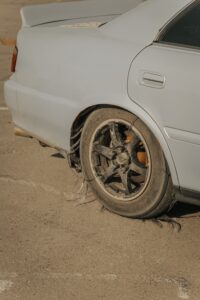
Traction Troubles: Grip on the Road
**The Road Less Gripped**
Feathered tires are like shoes with worn-out soles – they struggle for grip, especially on wet or slippery surfaces. This compromised traction affects your vehicle’s stability and safety.
Road Noise: Hushing the Ride
**Whispers of Unease**
Ever noticed your ride becoming noisier over time? Feathered tires can be the culprits. As they roll, the uneven edges create more noise, transforming your peaceful ride into a not-so-quiet affair.
Fuel Efficiency Drop: Rolling Resistance
**Burning Extra Fuel**
Feathered tires increase rolling resistance. In simpler terms, your engine must work harder to move the vehicle, resulting in decreased fuel efficiency and higher fuel consumption.
Tire Longevity: Lifespan Shortened
** Tread on Borrowed Time**
Feathered tires wear out faster than their evenly worn counterparts. This means you’ll be shopping for new tires sooner than anticipated, denting your wallet and the environment.
Preventing Tire Feathering
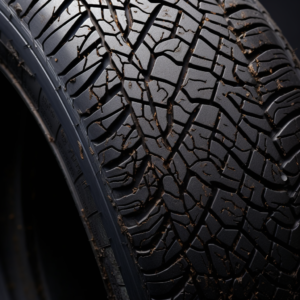
Regular Tire Inspections: A Visual Check
**Eyes on the Treads**
Frequent tire inspections are your first line of defense. A visual check for feathering, uneven wear, and other irregularities can catch issues before they escalate.
Wheel Alignment: Keeping Things in Line
Aligning for Longevity
Regular wheel alignment checks, especially after encounters with potholes or rough terrain, ensure that your tires maintain even contact with the road, thwarting feathering.
Tire Rotation: Equalizing the Load
** A Balancing Act**
Adhering to the manufacturer’s rotation recommendations ensures that all tires share the load equally. This prevents certain tires from wearing faster and feathering prematurely.
Proper Tire Inflation: Balancing the Pressure
**Inflation Equation**
Checking and maintaining proper tire pressure according to your vehicle’s specifications is crucial. It aids in even tread wear and reduces the risk of feathering.
Gentle Driving Habits: A Smooth Ride
**Drive with Care**
Adopting a more gentle driving approach – smooth accelerations, gradual braking, and controlled turns – reduces stress on the tires and minimizes uneven wear patterns.
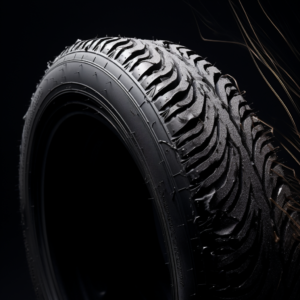
Final Takeaway-
Tire feathering might sound mysterious, but it’s a phenomenon that can impact your vehicle’s performance and safety. By comprehending its causes and effects, and by adopting proactive maintenance measures, you can extend the life of your tires, ensure better traction, and enjoy a smoother and quieter ride. Remember, a little care goes a long way in preserving both your tires and your driving experience.
**Frequently Asked Questions (FAQs)**
- **Is tire feathering dangerous?**
– Feathering affects traction and tire longevity, which can compromise safety. It’s crucial to address the issue promptly.
- **How often should I rotate my tires?**
– Follow your vehicle manufacturer’s recommendations, usually every 6,000 to 8,000 miles.
- **Can I align my wheels myself?**
– Wheel alignment is best left to professionals with the right equipment for accurate adjustments.
- **Do feathered tires need replacement?**
– Depending on the extent of wear, you might need new tires sooner. Consult a tire professional for guidance.
- **Can aggressive driving habits be corrected?**
– Yes, adopting smoother driving habits can minimize tire stress and prevent feathering over time.
